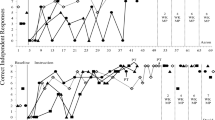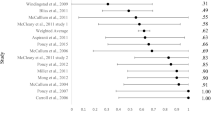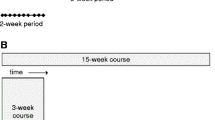Abstract
Two experiments are reported which test the effect of increased three-term contingency trials on students' correct and incorrect math responses. Experiment 1 included two junior high school students in need of special instruction in mathematics while in Experiment 2 two other students with similar instructional needs from the same classroom were studied. In the first experiment the increased rate of presentation (3 times the baseline rate) was done without regard to whether the antecedent teacher presentations to the student were presented vocally or in written form; in the second experiment, the rates of presentation were systematically rotated across written and vocal presentations. The dependent variables were rate per minute of correct and incorrect responses of students (vocal or written). The experiments used designs incorporating features of the multiple baseline (Students A and B) and reversal (Students B, C, and D). The data showed that increasing the number of three-term trials increased correct rates while incorrect rates remained relatively low. The second experiment replicated these findings with two other students and found that the treatment effect occurred independently with vocal and written antecedents when each was isolated. The results warrant further research to test whether or not rates of presentation of three-term contingency trials are predictors of effective instruction.
Similar content being viewed by others
References
Carnine, D. W. (1976). Effects of two teacher-presentation rates on off-task behavior, answering correctly, and participation.Journal of Applied Behavior Analysis, 9, 199–206.
Eicholz, R. E., O'Daffer, P. G., & Fleenor, C. R. (1985).Addison-Wesley mathematics series. Reading, MA: Addison-Wesley.
Greer, R. D. (1991). The teacher as strategic scientist: A solution to our educational crisis?Behavior and Social Issues, 1(2).
Greer, R. D., McCorkle, N., & Williams, G. (1989). A sustained analysis of the behaviors of schooling.Behavioral Residential Treatment, 4, 113–141.
Hall, R. V., Delquadri, J., Greenwood, C. R., & Thurston, L. (1982). The importance of opportunity to respond in children's academic success. In E. B. Edgar, N. G. Haring, J. R. Jenkins, & E. E. Pious (Eds.),Mentally handicapped children: Education and training (pp. 58–88). Baltimore, MD: University Park Press.
Ingham, P., & Greer, R. D. (in press). Supervisor effects on students and teachers behaviors in observed and generalized settings.Journal of Applied Behavior Analysis.
Holt School Mathematics Series. (1974). Holt, Rinehart, & Winston.
Jastak, J., Bijou, S., & Jastak, S. (1978).Wide range achievement test. Wilmington, DE: Jastak Associates.
Koegel, R. L., Dunlap, G., & Dyer, K. (1980). Intertriai duration and learning in autistic children.Journal of Applied Behavior Analysis, 13, 91–99.
Loos, F. M., Williams, K. P., & Bailey, J. S. (1977). A multielement analysis of the effect of teacher aides in an “open-style” classroom.Journal of Applied Behavior Analysis, 10, 437–448.
Purkey, S. C., & Smith, M. S. (1983). Effective schools: A review.Elementary School Journal, 83, 427–452.
Rutter, M. (1983). School effects on pupil progress: Research, findings and policy implications. In L. S. Shulman & G. Sykes (Eds.)The handbook of teaching and policy (pp. 25–94). New York: Longman.
Sainato, D. M., Strain, P. S., Lefebreve, D., & Rapp, N. (1987). Facilitating transition times with handicapped preschool children: a comparison between peer-mediated and antecedent prompt procedures.Journal of Applied Behavior Analysis, 20, 285–291.
Schuster, J. W., Gast, D. L., Wolery, M. P., & Guiltinan, S. (1988). The effectiveness of a constant time-delay procedure to teach chained responses to adolescents with mental retardation.Journal of Applied Behavior Analysis, 21, 169–178.
Skinner, B. F. (1968).The technology of teaching. New York: Appleton-Century Crofts.
Stallings, J. (1980). Allocated academic time revisited or beyond time on task.Educational Researcher, 9(11), 11–16.
Sulzer-Azaroff, B., & Mayer, G. R. (1986).Achieving educational excellence using behavioral strategies. New York: Holt, Rinehart & Winston.
Vargas, E. A., & Vargas, J. S. (1991). Programmed instruction: What it is and how to do it.Journal of Behavioral Education, 1(1).
Wechsler, D. (1974).Wechsler intelligence scale for children (revised). New York: The Psychological Corporation.
Wilson, R. (1987). Direct observation of academic learning time.Teaching Exceptional Children, 19(2), 13–17.
Author information
Authors and Affiliations
Rights and permissions
About this article
Cite this article
Albers, A.E., Greer, R.D. Is the three-term contingency trial a predictor of effective instruction?. J Behav Educ 1, 337–354 (1991). https://doi.org/10.1007/BF00947188
Accepted:
Issue Date:
DOI: https://doi.org/10.1007/BF00947188




